Gem in the Spotlight: Opal
A Kaleidoscope of Colors and Mythical Charm
Opal has been described as containing the wonders of the skies, sparkling rainbows, fireworks, and lightning. Its dazzling play of color is totally unique in the gem world, and the lore that surrounds it is almost as colorful as the gem itself. Opal is the traditional birthstone for those lucky enough to born in October, and it is found in a huge variety of colors (sometimes all within the same stone).
Gemology of Opal
Opal’s captivating dance of colors is a result of its unique internal structure. This gemstone is composed of tiny silica spheres arranged in a pattern, which diffract light and create the spectacular play of colors known as opalescence. The colors seen in an opal depend on the size and arrangement of these spheres as well as the background colors and the gem’s transparency. This captivating optical phenomenon gives rise to a diverse range of opal varieties each possessing its own distinctive beauty.
The distance between each sphere of silica causes interference with light breaking it up into its spectral hues. Depending on how the spheres are packed together, you will get different colors. Opals can display just about every color of the rainbow, but hues of green and blue are the most common.
Typically the higher end opals have a darker body color, and a wide range of colors. Red carries more value and is by far the rarest color that opals can display. Stones with larger patches of color are valued higher than those that display only small pins (pinfire) or no play of color at all. Opals that don’t display any play of color are called “common opal”.
Opal has a refractive index of 1.37 – 1.47 and a Mohs hardness of 5.5-6. This makes it one of the softest gemstones commonly used in jewelry. For reference, here are the Mohs hardness values for some other gemstones you may know: Diamond 10, Sapphire 9, Amethyst 7, and Peridot 6. Turquoise is about as hard as opal, but you would need to consider Pearl or Amber (both 2.5) to find a commonly used gem that is softer than opal.
Common Opal Treatments
There are several different treatments that can be applied to opals to alter their appearance. By far the most common is “sugar” or “smoke” treating a white opal to give it a darker body color. This is a simple treatment that involves placing the stones in a sealed environment which is then filled with smoke. Opals are porous by nature, so small particulates can be absorbed, if the stones are subjected to them for long enough. A white opal can be darkened to have a gray body color, and gray opals can be darkened to have a black body color. A gemologist with right training and equipment will be able to detect this treatment.
Opals can also sometimes be dyed, giving them an unnatural but fascinating body color such as a vibrant green or pink. Some opals that have cracked can sometimes be reused by making “mosaic opals” gluing smaller broken pieces of opal together in something similar to stained glass windows.
This is also a good time to discuss doublet and triplet opals. These gems are manufactured using a thin slice of natural opal. In doublets, a lapidarist will use a piece of ironstone or black onyx and glue the fragile piece of opal to it before cutting and leaving them glued together after the fact to be set into jewelry. In triplets, that thin piece of opal is sandwiched between a piece of onyx and a clear piece of laboratory grown quartz (the same material that is commonly used for watch crystals). This helps show off the opal’s beauty while keeping it safe and strong. Doublets and triplets are much less expensive than other forms of opals because you only need a paper thin slice to make them.
History and Lore of Opal
Opal’s rich history is intertwined with beliefs and legends that have shaped its significance across cultures for centuries. In ancient Greece, opal was regarded as a stone of foresight and prophecy, believed to offer its wearer a glimpse into the future. The Romans, on the other hand, saw opal as a symbol of hope and purity, associating it with positive virtues. Opal was even thought to possess protective and healing properties, guarding against disease and enhancing one’s eyesight.
Pliny, a prominent Roman scholar in the first century AD, eloquently described opal like this: “For in them you shall see the living fire of the ruby, the glorious purple of the amethyst, the sea green of the emerald, all glittering together in an incredible mixture of light.”
During the Middle Ages, opal gained an interesting reputation for preserving blonde hair and was believed to lose its luster in the presence of illness, particularly the plague. In Arabian cultures, opal was considered a celestial gift that rained down during lightning storms and carried with it the magic of the heavens.
Arguably the most famous opal of all time is “Aurora Australis”. It was found in 1938 in Australia’s Lightning Ridge. It is renowned for its extraordinary play of colors and its rarity. This opal is quite large, weighing approximately 180 carats (36 grams) and measuring 3 x 1.8 inches long. Its size and quality make it an exceptionally valuable gemstone.
Care and Cleaning
While opal’s enchanting colors may seem otherworldly, it is important to care for this delicate gemstone to maintain its brilliance. Opal is not as hard as some other gemstones, making it susceptible to scratches and damage from sharp impacts. Household chemicals and extreme temperature fluctuations can also harm opals, so gentle care is essential.
To keep opal at its luminous best, wiping it clean with a soft cloth is recommended. Avoid the use of home ultrasonic machines or abrasive jewelry cleaners that could potentially damage the stone’s surface.
For more valuable stones, setting them in a pendant or earrings instead of a ring will help them last as long as possible. With proper care opals can last for generations.
Opals have very high water content, typically hovering around the 5-10% mark. As opals dry out over time they can sometimes crack at the surface, which is called crazing. As of this writing there aren’t any surefire ways to prevent crazing, but there are ways that you can help and a few ways that you can make it worse. Wrapping your opals in a soft cotton cloth that is slightly moist can help their moisture content not evaporate out. On the contrary, storing your opals in a very dry place like a safety deposit box or a humidity controlled safe can accelerate evaporation and make crazing much more likely.
Hydrophane opals have a more porous structure which allows them to absorb and evaporate moisture out more readily. Hydrophane opals are much more common from Ethiopia or Mexico and are sometimes called water opals. As they absorb more moisture they can become more transparent and their play of color can become more vibrant. Rapid changes in their moisture content can cause them to crack though, so be careful not to submerge them in water or let them dry out too quickly. Amazingly, hydrophane opals can hold up to 20% water content.
Types of Opal
- Black Opal: Revered for its dark gray to blackish body color, black opal is a captivating gem found exclusively in Australia’s Lightning Ridge and Mintabie. The deep, rich body color enhances the brilliance of the opalescent play of colors creating a mesmerizing visual display.
- Crystal Opal: Renowned for its transparency and the multilayered symphony of colors it exhibits, crystal opal is a rare and beautiful stone. Its value lies in the intricate layers of color that dance within the gem creating a dynamic and even entrancing visual experience.
- White Opal: This term refers to any opal that has a white body color. These can still have a very strong play of color, but they typically aren’t as vibrant as black opal.
- Ethiopian Opal: Technically this refers to any opal from Ethiopia. That said, the term is usually used to refer to crystal opal that has a slight yellowish to orange body color. Many Ethiopian opals are hydrophane (see above). Other names for this kind of opal include: jelly opal and water opal.
- Australian Opal: This is a somewhat vague term that can be used to describe any opal that comes from Australia. In everyday conversation, some people use this term to describe white opals while others use it to refer to black opals. Because of this, we typically avoid this term and use one of the more specific names whenever possible.
- Mexican Fire Opal: Known for its vibrant orange body color, many of these stones have little to no play of color. The best stones have strong greens and blues that flash through the orange body color.
- Boulder Opal: Boulder opals are gem opal material that still incorporates some of its surrounding material. Most commonly, this material is dark brown ironstone from Australia.
This concludes our journey through the enchanting world of opal. Its rich history, remarkable optical properties, and wide range of varieties make opal one of the most exciting gems you can own today. If you are looking for that special piece of opal jewelry to add to your collection, the gemologists at Arden Jewelers would love to help. Contact us anytime.
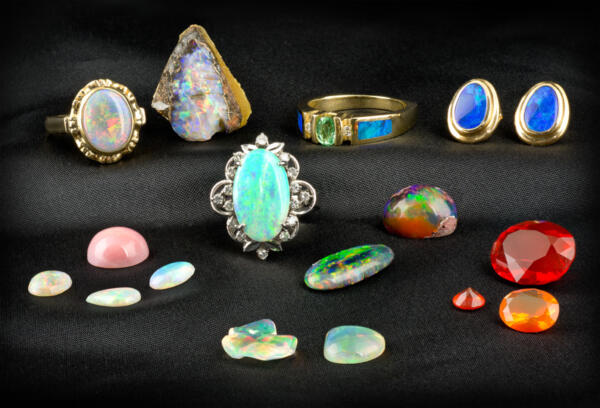
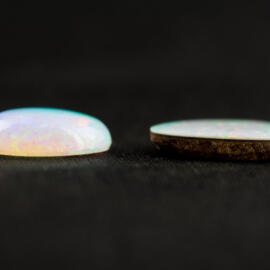
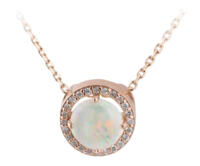
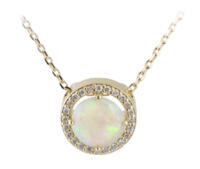
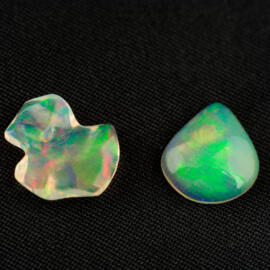
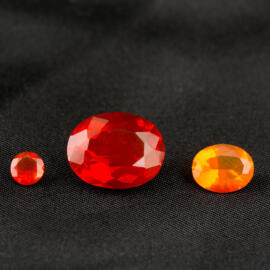
Wow, that article was so interesting. Opals are definitely gorgeous!
Thanks for the kind words, Vicki. I’m so glad you enjoyed the article. 🙂
I have a lot of rough opal stones I was wondering how much they would be worth?
Hi Joe, thanks for reaching out to us. At this time, we do not buy rough opal. I would recommend you contact a local gem cutter or lapidary to see if they would be interested in them.
Ok thank you I have one more question I have a opal and it’s colors is black with different colors is it black opal or maybe could be a different opal
Hi Joseph, good question. Yes, black opal (like white opal) actually has many colors and varieties. For example, checkout these black opal pieces we have available for sale right now: Vintage Black Opal Ring With Diamond Halo and Asymmetrical Black Opal Bezel Solitaire Ring.
I have 4 opal stones …necklace two opals and pair earrings pinky nail size looking to sell. Appx value and interest.
Hi Penny, thanks for reaching out to us. We would potentially be interested in those opals. If you could email us (service@mygemologist.com) some pictures of the pieces, we can give you a better idea of what they might be worth.